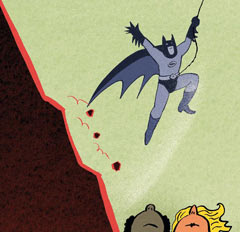Buttonwood
With one bound…
Jul 30th 2009
From The Economist print edition
The stockmarket recovery still faces some serious tests

Illustration by S. Kambayashi
FACING certain death, Batman can always produce just the right tool from his utility belt and leap to safety. The stockmarket seems to be working on the same trick. In March shares were spiralling relentlessly downwards. But the Dow Jones Industrial Average climbed back above the 9,000 level on July 23rd and London’s FTSE 100 index rose for 11 trading days in a row to July 27th, equalling its best-ever run. Most of the world’s stockmarkets are now in positive territory for the year.
Such rises need to be set in context. The Dow passed 9,000 for the first time back in April 1998 and it is still a long way below its peak of 14,165, reached in October 2007. The speed of this year’s rally in part reflects the scale of the previous decline. Nevertheless, the change of mood is remarkable, given that earlier this year many feared a repeat of the Depression.
Two factors are commonly cited as being behind the rally. The first is a growing conviction that the worst of the economic downturn is over. Although second-quarter GDP data have so far been mixed (disappointing in Britain, better than expected in Singapore), forward-looking data such as purchasing managers’ surveys are generally encouraging.
The second factor is the second-quarter reporting season in America. According to Morgan Stanley, 57% of companies in the S&P 500 index to have reported results have beaten expectations. Only 25% have disappointed. It is worth remembering, though, that profits are still depressed. Earnings were 28.8% lower than in the same period of 2008. Leaving out financial firms, they were still 16.7% down.
The rally may also be benefiting from at least two virtuous circles. The first is that leading economic indicators usually include the stockmarket itself as a key component. Recent improvements in these indicators—the euro-zone figures rose by 1.5% in June, for example, on the back of similar increases in April and May—are in turn taken by equity investors as a bullish signal.
The second factor is more technical. David Shairp of JPMorgan Asset Management says that lower stockmarket volatility is reducing the perceived risk of investing in equities, relative to bonds. In turn, volatility tends to fall when the stockmarket is rising.
The relative attraction of equities may be the key to the rally. The return on cash is many countries is virtually zero. Long-dated government bonds yield 3-5% in America and the euro zone. Many investors are nervous about the volume of issuance and the potential for inflation. At the end of 2008 these low yields did not matter: investors were more concerned with the return of capital than the return on it. They are now becoming less risk-averse and heading back to equities and to corporate bonds, where spreads (the excess interest rate paid to investors to reflect higher risks) have fallen despite more defaults.
How long-lasting will the recovery be? Its scale has hurt one bullish argument for shares: that they are historically cheap. At their March lows they did appear attractive on two long-term measures—the cyclically adjusted price-earnings ratio (which averages profits over ten years) and the “q” ratio (which compares the market value of companies to the replacement cost of their assets). After the rebound, Andrew Smithers, an economist, reckons the American market is about 20% overvalued on these gauges.
The period when shares were a bargain was remarkably short. As Jeremy Grantham, a veteran investor, has remarked: “After 20 years of more or less permanent overpricing of the S&P, we get five months of underpricing. There is no justice in life.” Mr Grantham’s lament reflects an underlying problem: valuation often fails to be a good short-term guide to the stockmarket’s prospects.
The big issue for the market may arrive, ironically, if the bulls are right. If economic recovery does occur in 2010, it will be because the authorities have thrown everything, from tax cuts to quantitative easing, at the problem. At some point they will have to withdraw the stimulus. How will consumers cope if both taxes and interest rates are rising at the same time? American consumer confidence has already declined in each of the past two months, even though rising share prices are normally good for sentiment.
If governments and central banks do not tighten policy, government-bond investors may take fright, pushing up yields and tightening monetary conditions on their own. In short, there are plenty of risks. Batman may win every hand but equity investors should still fear the Joker.
Copyright © 2009 The Economist Newspaper and The Economist Group.
0 comments:
Publicar un comentario